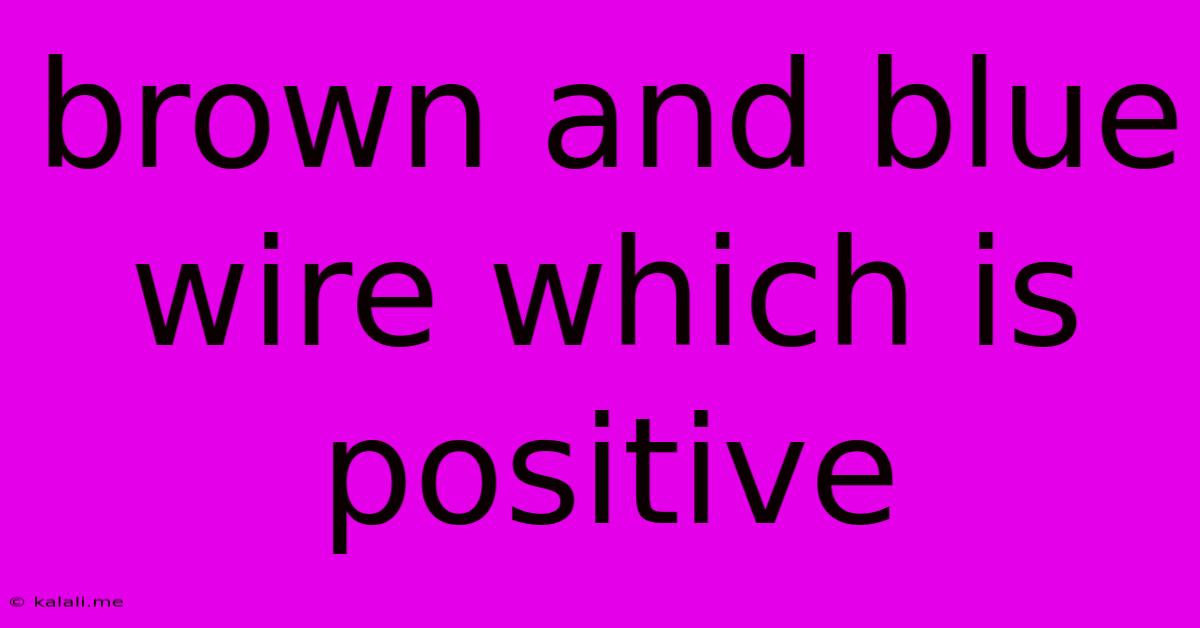Brown And Blue Wire Which Is Positive
Kalali
Jun 08, 2025 · 3 min read

Table of Contents
Brown and Blue Wire: Which One is Positive? Understanding Electrical Wiring
Determining which wire is positive (or "live") in a brown and blue wire configuration is crucial for electrical safety. This article will clarify the standard color coding used in many regions, explain potential exceptions, and highlight the importance of verifying wire polarity before working with any electrical system. Always prioritize safety and consult a qualified electrician if you're unsure.
In many parts of the world, including the UK and several other European countries, the brown wire is the live wire, carrying the positive voltage, while the blue wire is the neutral wire. This color-coding system aligns with international standards designed to minimize confusion and accidents. However, it's essential to remember that this isn't a universally applicable rule.
Understanding Electrical Color Codes: A Regional Overview
While brown and blue are commonly associated with live and neutral respectively, regional variations exist. In some regions, other colors might signify live or neutral. These differences emphasize the importance of confirming the wire polarity before any electrical work.
- North America: Uses black or red for hot (live) wires and white for neutral. Green or bare copper is typically used for grounding.
- Australia: Employs brown for live, blue for neutral, and green/yellow for earth.
- Other Regions: Color codes may vary depending on the local electrical standards and age of the wiring.
Why is Identifying the Positive Wire Crucial?
Knowing which wire is positive is vital for several reasons:
- Safety: Incorrectly connecting live wires can lead to electric shock, equipment damage, or even fire.
- Functionality: Many electrical devices and components require correct polarity for proper operation. Reversing the polarity can cause malfunction or damage.
- Troubleshooting: Identifying the live wire is essential during electrical troubleshooting and repair.
How to Verify Wire Polarity: Safe Practices
Never assume wire polarity based on color alone. Always verify using appropriate testing equipment:
- Voltage Tester: A non-contact voltage tester can safely detect the presence of voltage without direct contact.
- Multimeter: A multimeter is a more versatile tool that can measure voltage, current, and resistance, providing a more precise verification of polarity.
Before attempting any electrical work, ensure you have the necessary safety precautions in place, including:
- Turning off the power: Always switch off the power at the circuit breaker before working with any wires.
- Double-checking the power is off: Use a voltage tester to confirm the power is off before touching any wires.
- Using appropriate personal protective equipment (PPE): This includes insulated gloves, safety glasses, and appropriate clothing.
Exceptions and Older Wiring: Cautions
Older wiring systems might not adhere to current color-coding standards. In such cases, tracing the wires back to their source or using a voltage tester is crucial to determine the polarity. Never rely on color alone in older installations.
In conclusion, while brown is generally associated with the positive (live) wire and blue with the neutral wire in many regions, it's imperative to verify polarity using proper testing methods before working with any electrical system. Prioritizing safety and consulting a qualified electrician ensures safe and efficient electrical work.
Latest Posts
Latest Posts
-
Cancel Noise Background For One Way Recording
Jun 08, 2025
-
Does Rice Wine Vinegar Need To Be Refrigerated
Jun 08, 2025
-
How To Create A User In Linux
Jun 08, 2025
-
Why Is There A Helicopter Circling
Jun 08, 2025
-
Why Doesnt My Toilet Flush All The Way
Jun 08, 2025
Related Post
Thank you for visiting our website which covers about Brown And Blue Wire Which Is Positive . We hope the information provided has been useful to you. Feel free to contact us if you have any questions or need further assistance. See you next time and don't miss to bookmark.